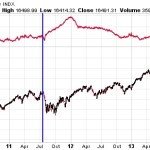The Missing Link For A Stock Market Crash | Zero Hedge

For months we have been warning about excessive optimism on the stock market, since it was clear that it needed a break. Coincidence or not, lately it has been seemingly impossible for the market to take it to the next level. Many indices are still listed near or at their all-time highs (e.g. the S&P 500), but sensitive sectors and segments (e.g. technology and small caps) have been nervously exploring the downside. It should not be too much of a surprise, as a consequence, that investors have become increasingly hesitant in this uncomfortable ‘grey area’.
And that feeling is completely justified; most investors remember the crash of 2008 and its aftermath like it happened yesterday. Their fears nurtured a five-year long bull market, since a big correction is only preceded by a period during which everyone wants a piece of the market. In 2013 the negative sentiment turned around and retail investors returned to the market en masse, evidenced by the strong increase in online brokerage activity. But when small-time investors show up to the party, the bull market is usually on its last legs. It is the beginning of the end…
From a technical perspective, we still are in the same environment we have been talking about for weeks: the distribution pattern, which consists of dramatic down moves on high volume and unconvincing moves to the upside on declining volume. If you combine this with the falling stock prices of many leading stocks, you have the recipe for a market disaster. We are, moreover, not the only analysts who are sending out warning signals. Hedge fund god, David Tepper, is wary about this market and the godfather of technical analysis, Ralph Acampora, is even warning investors to brace for a 15 to 25 percent correction in the stock market in the coming months. That is quite the prediction! Both gentlemen were big supporters of the bull market until recently but, considering their spotless track record and timing, it would not be wise to ignore their statements.
Nevertheless, there is one item that is missing to warrant a complete ‘potential stock market crash’: stress in the credit markets. With previous market corrections there was always a lot of tension and today there is an utter lack of ‘credit stress,’ evidenced by the low TED spread. That is the difference between the interest rates on interbank loans and on short-term U.S. government debt. The TED has always been a great barometer to gauge for potential adversity on the market.
As you can see on the above chart, an upward breakout of the TED spread has always been followed by a correction in the stock market in the weeks after. The market was able to recover every time, however, thanks to the intervention of the central banks who flooded the financial sector with fresh cash, wiping away the stress in the credit market.
Today, the market is floundering because of the fact that those same central banks, with the Fed in the lead, are indicating that their flexible monetary policies have run their course. They are even talking about an exit strategy, which would mean the end of QE and the beginning of higher short-term interest rates. Increased short-term interest rates are not desirable all the same, because that would mean that the yield curve would flatten out (less income for the financial sector), which indicates less credit activity and, consequently, trouble for economies that are overburdened with debt. The term ‘inverted yield curve’ (when the short-term yield is higher than the long-term yield) even popped up, which is a phase in the credit market that is basically a one-way ticket to an economic recession.
To be clear: we are not there yet. Central bankers will do everything it takes to avoid new credit issues and expectations have already been extensively ‘managed’ by Mario Draghi of the ECB, who was hinting at a monetary intervention. The strong euro is posing problems, but we cannot relieve ourselves of the impression that there is more trouble to come from the European credit system. The monetary authorities are particularly alert, but for now the coast remains clear.
As a consequence, we are advising investors to be cautious and there are plenty of signals coming from the market that indicate that vigilance is a wise choice at this time. Different technical elements point to (underlying) changes that have always been harbingers of corrections in the past. It is probably too early for a full-on stock market crash, however, and we would need to see more indicators of stress in the financial system to get there. But history has taught us that the way down travels fast if things go awry in the credit market. If we can hold off the credit stress and if the markets can convincingly put new highs on the board, however, we will start to feel positive about the stock market once again. Until that time, however, we are taking cover behind gold, silver, and some cash.
>>> Protect your Port! Download The FREE Stock Market Guide
Sprout Money offers a fresh look at investing. We analyze long lasting cycles, coupled with a collection of strategic investments and concrete tips for different types of assets. The methods and strategies from Sprout Money are transformed into the Gold & Silver Report and the Technology Report.
Follow us on Twitter @SproutMoney
Average:
4.5
Your rating: None Average: 4.5 (4 votes)
Link:
The Missing Link For A Stock Market Crash | Zero Hedge
See which stocks are being affected by Social Media

